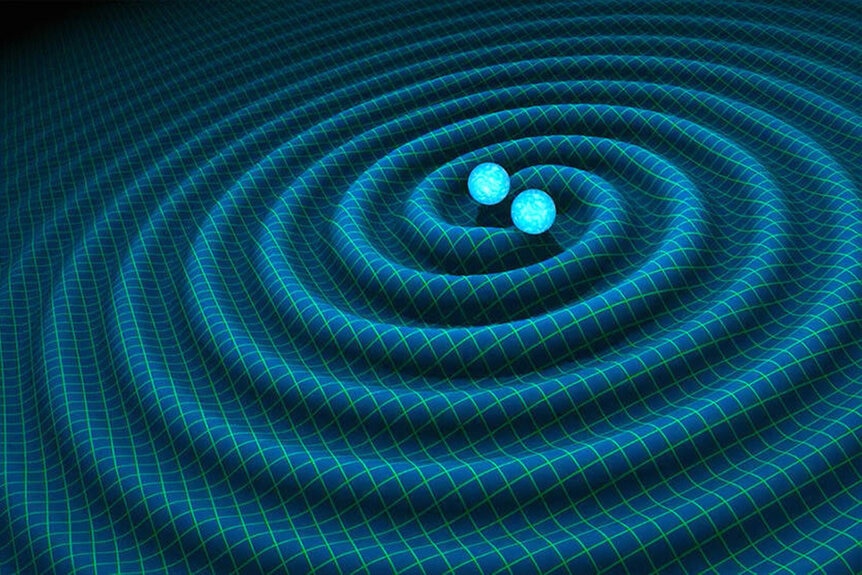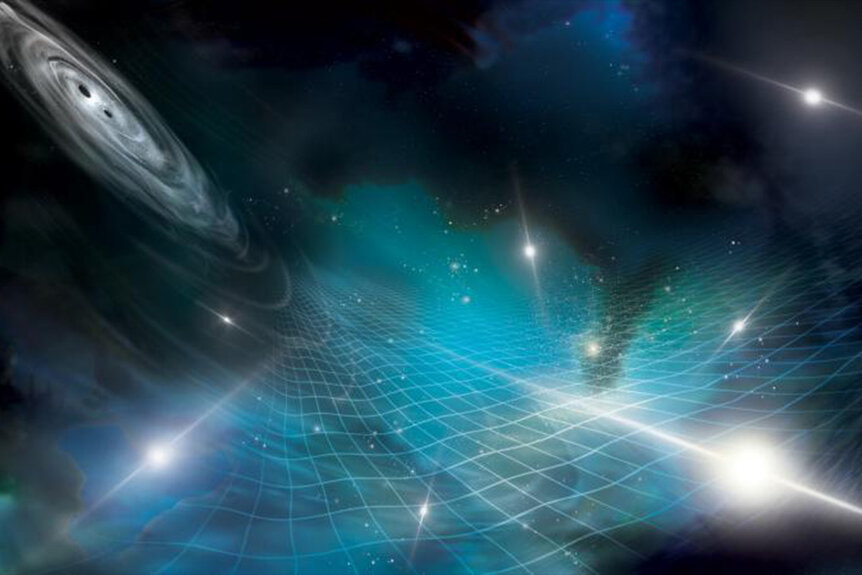Create a free profile to get unlimited access to exclusive videos, sweepstakes, and more!
When Black Holes Collide: Universe-Shaking Evidence of Gravitational Wave Background Signal Found
Scientists hear the tiny taps of massive gravitational feet.
If you’ve ever watched a figure skater spinning on the ice, you might have noticed that they spin a lot faster when they tuck their arms and legs in and they slow down when they spread them out. That’s because rotational inertia is always conserved so objects with smaller diameters spin more quickly than larger objects with the same inertia. It’s a quirk of physics which allows skaters to spin until they puke and for the formation of pulsars. More on that in a minute.
Astronomers hit the ball out of the solar system when they named pulsars. They are as weird and as exotic as they sound, just as comfortable in a textbook as they are in actual space. In a Season 2 episode of Farscape (streaming now on Peacock!), the crew of Moya fly through a region of the uncharted territories known as The Five Pulsars. It is so named for the collection of pulsars it houses, which seem to affect some of the crew in unusual ways. As it turns out, there’s something stranger going on, just outside of their view.
RELATED: LIGO Sees First Ever Gravitational Waves as Two Black Holes Eat Each Other
The NANOGrav collaboration, an international team of scientists announced evidence of a gravitational wave background signal for the very first time. The news made headlines across all of the major science publications and has been the talk of science town since even before the announcement. So, what’s the big deal?
What are gravitational waves and how are they detected?
For most of humanity’s scientific career, we’ve been limited to the things we could actually see with our eyes. The invention of microscopes and telescopes expanded that view to the very small and the very far away, but even early astronomy was entirely optical. It wasn’t until later that we realized we could see more of the universe by looking for parts of the electromagnetic spectrum we can’t see.
Things like radio waves, X-rays, and infrared are all types of light, but their wavelengths are either too short or too long for our eyes to detect. We need machines to detect and translate that information for us. Over the last few decades, scientists have been working on new tools for detecting a totally different type of invisible signal, that of gravitational waves.
Most of the time astronomy is an activity which involves observing things in space, detecting gravitational waves is the practice of detecting movements in the fabric of spacetime itself. The existence of gravitational waves, the result of violent collisions of supermassive objects like black holes or neutron stars, was predicted decades ago but only confirmed in 2015. Researchers used LIGO, a pair of interferometers four kilometers on a side, made up of two perpendicular lasers to detect the merger of two black holes. Because we know the exact distance of the instrument and the precise speed of light, researchers know exactly how long it should take laser light to make the trip from one end of the instrument to the other. If the trip takes longer or shorter than it should, that’s a pretty good indication something is afoot.
When a gravitational wave passes through the instrument, the fabric of spacetime is stretched or compressed temporarily and the travel time of the laser light is altered. That’s how LIGO detects gravitational waves, but even it is limited in what it can see. Despite its huge length, LIGO can only detect short gravity waves with wavelengths measured in kilometers. Scientists suspected that much larger gravitational waves might be out there, but we didn’t have any good way to detect them. It would be like trying to see the curvature of the Earth from the ground. We needed a bigger instrument.
Measuring gravitational waves bigger than the solar system
To pick up waves that large, astronomers needed an instrument larger than anything we could possibly construct. To detect low-frequency gravitational waves we would need an interferometer measured not in kilometers but in lightyears. Fortunately, scientists figured out a way to make the universe do the heavy lifting for us. And that’s where pulsars come back in.
When massive stars die, they sometimes explode in a violent supernova. The outer layers explode outward, spreading enriched chemicals across space, and they leave a solid core behind. That core is a neutron star with all of the rotational inertia of its former, larger self, but with a much tighter diameter. As a result, they spin wildly, sometimes hundreds of times a second.
These millisecond pulsars are scattered throughout the Milky Way and when their radio beams point toward Earth, we can detect their flickering light like distant cosmic lighthouses. Pulsars are useful because they pulse at such a consistent rate, allowing scientists to use them to measure the time between events against the background rate of pulses. Measuring the travel time of light across large distances is precisely how LIGO works, which got scientists thinking maybe they didn’t need to build a new instrument. They just needed to use the ones already there.
RELATED: Turning the Moon into a Gravitational Wave Detector
The NANOGrav team spent 15 years studiously measuring the distance to every pulsar they could find and documenting the time between pulses, looking for anomalies. In effect, they made an interferometer the size of the galaxy by stringing pulsars together and paying close attention to the travel time of their light.
Instead of measuring one event, like the black hole merger detected by LIGO in 2015, this new signal could represent the background gravitational waves of the universe. There are a couple of suspects for the source of the signal. It might be that we’re picking up the rumbles or black hole binaries spread out across the universe. As paired black holes orbit one another they drag nearby stars around with them. The drag slows them down and their orbits decay. As they get closer, gravitational perturbations ripple out through spacetime. Get enough black holes doing the tango and you might pick up a signal in the rumble of the cosmic dance floor.
Alternative explanations include interactions with dark matter or theoretical tangled cosmic strings. It might also be the quiet jostling left over from the early universe, potentially giving us a window into the bizarre physics of the Big Bang.
We’re in early days and we need more evidence before anyone will feel comfortable putting their chips down on one explanation or another. But we just figured out how to look at the universe a little more clearly, and whatever we end up seeing is sure to be exciting.
Catch Farscape, streaming now on Peacock!



















